Neil Clarke's Blog, page 3
March 21, 2023
Submissions Update
After making some changes to our software and firewall settings, we quietly reopened submissions at Clarkesworld on March 12th. The second submission received resulted in a ban over the use of machine-generated content. This wasn’t a surprise.
Our goals are:
Acquire more legitimate submissions in hopes of building up our inventory.Test some simple deterrents in hopes of reducing the quantity of spam submissions. This buys time for the first goal.Collect data and identify patterns in spam submissions.As of a few minutes ago, we had received 576 submissions and processed 474 of them. 93 have resulted in bans and 7 have been marked as suspicious (a new category meaning they might have used those tools). The overall percentage of spam is down, but the effectiveness of our changes is slightly masked by the natural boom in submissions that follows being closed. There’s also an element of “submit while you can” in there as it is entirely likely we’ll have to close if prior trends are still in effect. (It’s too early to say.) We have data to show that we are cutting off at least 10% of the attempts before they reach the submission page. It’s a trick we don’t expect to last, but at least provides us with some amusement and more time.
Do we have a solution?
No, but we do have an idea that will take some time to implement and we’re happy enough being able to see at least one step on the path ahead. That first step is resembles a spam filter, but it’s not exactly the same. That should help us prioritize incoming submissions and avoid having to adopt some of the solutions that would have disproportionately impacted new and international writers. This will create extra work that none of us want, but it beats some of the more draconian alternatives. Hopefully this can hold until we can see the next step. Continued growth could overwhelm this model too.
And because, inevitably, there is someone in the crowd who is blinded by the tech and screaming “judge it for the quality” … No, that would be a waste of time. For starters, those stories are absolutely terrible right now. Sure, it might get better, but maybe you should go read this excellent article by Ted Chiang before you romanticize it too much. There’s also the matter of rights, specifically a lack of clear ownership of these works. I simply can’t sign a contract without those. Or perhaps I’m just angry and lashing out over these companies gleefully using the copyrighted works of others as part of their training. (Before you even start the “but that’s how humans learn” argument, I suggest you find out how humans really learn first.)
The fact of the matter is that we have rules. Every publication has rules. Our rules say we don’t want generated content. They also say that we don’t want horror. If someone submits horror, you wouldn’t have a problem with me completely ignoring them, so what’s the problem here? I’m sure you have house rules too. Like… don’t throw the silverware in the garbage. How would you feel if someone did it anyway? What if half of your visitors did it? Wouldn’t you complain? Take action to keep it from happening?
Use these tools if you like. I’m not saying you can’t. Just don’t do it in my house.
March 10, 2023
Amazon Subscriptions
The day we’ve been dreading has come. It’s official now, Amazon is ending all print and digital subscriptions, ending a program that has been instrumental to the success of many genre magazines. This is the email they sent out today:
Dear Amazon Customer,
Thank you for being a valued Amazon Kindle Newsstand subscriber. We are writing to inform you that we have made the decision to stop selling Kindle magazine and newspaper subscriptions on Amazon.
According to our records, here are your monthly subscription(s):
Clarkesworld Magazine
You will continue to receive your issues through September 4, 2023 unless you decide to cancel. After that date, you will no longer be able to renew your subscription(s) through Amazon. You will still be able to read all issues that have already been delivered to you by visiting Your Kindle Library. If you wish to continue receiving content from a publisher directly, please visit their website for alternative subscription options. Visit Your Memberships and Subscriptions page on Amazon for more information at:
www.amazon.com/yourmembershipsandsubs....
Select digital magazine subscriptions are also available in Kindle Unlimited. XXXXXXXXXXXXXXXXXXX for more information
If you have any questions or require assistance, please visit the Newsstand FAQ or contact customer service.
Sincerely,
Amazon Newsstand Team
(LINKS REMOVED)
This is a substantial blow to the finances of our magazines. I go into our path forward and how this impacts us in this month’s Clarkesworld editorial. Summary: it will be rough and make our recent troubles with machine-generated submissions look like child’s play.
Current Amazon subscribers to Clarkesworld should visit:
https://clarkesworldmagazine.com/amazon-subscribers/
and subscribers to Forever Magazine should visit:
http://forever-magazine.com/amazon-subscribers.html
for details on how to continue your subscriptions. We’re hoping you stick with us.
February 15, 2023
A Concerning Trend
Since the early days of the pandemic, I’ve observed an increase in the number of spammy submissions to Clarkesworld. What I mean by that is that there’s an honest interest in being published, but not in having to do the actual work. Up until recently, these were almost entirely cases of plagiarism, first by replacing the author’s name and then later by use of programs designed to “make it your own.” The latter often results in rather ham-fisted results like this one I received in 2021:

These are the same sentences from the original story, “Human Error” by Raymond F. Jones, published in If (April 1956).

These cases were often easy to spot and infrequent enough that they were only a minor nuisance. Sometimes it would pick up for a month or two, but overall growth was very slow and number of cases stayed low. Anyone caught plagiarizing was banned from future submissions. Some even had the nerve to complain about it. “But I really need the money.”
Towards the end of 2022, there was another spike in plagiarism and then “AI” chatbots started gaining some attention, putting a new tool in their arsenal and encouraging more to give this “side hustle” a try. It quickly got out of hand:

(Note: This is being published on the 15th of February. In 15 days, we’ve more than doubled the total for all of January.)
I’m not going to detail how I know these stories are “AI” spam or outline any of the data I have collected from these submissions. There are some very obvious patterns and I have no intention of helping those people become less likely to be caught. Furthermore, some of the patterns I’ve observed could be abused and paint legitimate authors with the same brush. Regional trends, for example.
What I can say is that the number of spam submissions resulting in bans has hit 38% this month. While rejecting and banning these submissions has been simple, it’s growing at a rate that will necessitate changes. To make matters worse, the technology is only going to get better, so detection will become more challenging. (I have no doubt that several rejected stories have already evaded detection or were cases where we simply erred on the side of caution.)
Yes, there are tools out there for detecting plagiarized and machine-written text, but they are prone to false negatives and positives. One of the companies selling these services is even playing both sides, offering a tool to help authors prevent detection. Even if used solely for preliminary scoring and later reviewed by staff, automating these third-party tools into a submissions process would be costly. I don’t think any of the short fiction markets can currently afford the expense.
I’ve reached out to several editors and the situation I’m experiencing is by no means unique. It does appear to be hitting higher-profile “always open” markets much harder than those with limited submission windows or lower pay rates. This isn’t terribly surprising since the websites and channels that promote “write for money” schemes tend to focus more attention on “always open” markets with higher per-word rates.
This might suggest to some that it is in the best interest of a market to have limited submission windows, but I have no doubt that such reprieves would be short-lived. (That, however, might be all some editors need.) Others might seek the safety of solicited submissions or offering private submission opportunities to a narrower set of “known” authors instead of open calls. Editors might even find themselves having to push back on the privacy-minded desire among some authors to provide less contact information. Some might resort to blocking submissions from sources that mask their location with a VPN or other services. Taken a step further, others might employ regional bans as a strategy–much as we have seen happen with financial transactions–due to the high percentage of fraudulent submissions coming from those places.
It’s clear that business as usual won’t be sustainable and I worry that this path will lead to an increased number of barriers for new and international authors. Short fiction needs these people.
It’s not just going to go away on its own and I don’t have a solution. I’m tinkering with some, but this isn’t a game of whack-a-mole that anyone can “win.” The best we can hope for is to bail enough water to stay afloat. (Like we needed one more thing to bail.)
If the field can’t find a way to address this situation, things will begin to break. Response times will get worse and I don’t even want to think about what will happen to my colleagues that offer feedback on submissions. No, it’s not the death of short fiction (please just stop that nonsense), but it is going to complicate things.
January 25, 2023
2022 Clarkesworld Poll – Nomination Phase

The annual Clarkesworld Poll is now accepting reader nominations for your favorite Clarkesworld short story, novelette/novella, and cover art of 2022. Nominations will close THIS FRIDAY AT 8:00PM EST.
https://www.surveymonkey.com/r/clarkesworld2022
Show your favorites some love! This round of voting will determine our 2022 Finalists.
January 24, 2023
2022 Submissions by Length and Genre and Volume
When I updated the submissions system, I created a few new reports for story length and genre distribution, so the second in my 2022 submissions data dive will focus there.
We accept submissions of short stories (up to 7500 words), novelettes (7500-17500 words), and short novellas (17500-22000 words). Here’s a look submissions opened in 2022 by month:

I noticed that our inventory of novelettes was a bit shorter than normal in late September. The small growth in October is a direct result of call I put out on social media, but it was a very temporary effect.
And here’s how 2022 looks in comparison to previous years:

This graph clearly demonstrates when we’ve increased our word count limits, but it also confirms my suspicions about the downturn in novelettes. We’ll probably have to put out regular calls for more novelettes until this corrects itself. I would actually like to see this grow by more than a few percentage points in 2023.
Now let’s look at submissions opened by genre:

You can barely see them, but there are tiny spots of Horror in there. Those are people who ignored our guidelines, a warning on the old submissions page, and submitted a story anyway. Other typically includes a bunch of things we don’t publish, but is sometimes used by authors of magical realism stories when they can’t bring themselves to call it Fantasy. Blends are covered by SFF (Science Fiction blended with Fantasy), SFH (Science Fiction with Horror), and FH (Fantasy with Horror, or Dark Fantasy). Science Fiction was the most popular genre for our submissions in 2022.
Let’s compare 2022 to previous years:

Once upon a time, we did accept horror submissions. You can clearly see that ended in 2018. (A shrinking because it happened during 2018 and a virtual absence after.) From that point forward, Other and Dark Fantasy grew a little bigger. Some of that was caused by the redistribution of the percentages, but the majority of it can be attributed to some authors ignoring the guidelines. (They thought we wouldn’t notice when they hid horror in there.) Eliminating horror submissions did result in a decrease in submissions, so it was only a small percentage that decided to play that game.
Here’s a look at submissions opened by year:

Prior to 2018, we had annual increases in submission volume. You can see how eliminating horror impacted submissions in 2018 and 2019. (Most of the authors submitting horror at the time stuck to their genre, so declines of this amount were anticipated.) Courtesy of the pandemic, 2020 was a wild year for submissions and an anomaly in the data. 2021 and 2022 appear to demonstrate a return to stability and slow growth in submissions. There were some changes though… but that’s a story for next time.
January 23, 2023
Submissions by Country 2022
I’ll start this year’s dive into Clarkesworld Magazine submissions data with a by-country analysis. This builds on graphs I shared last year.
Note: Country data is determined by the originating IP address, which can obviously lead to some errors. For example, an American author living in Canada will be listed under Canada and a Chinese author living in China, but using a VPN located in Germany would be listed under Germany. Country names are provided by a third party database we use to process this data.



61.8% of all submissions came from the USA. It’s hard to tell in the graph, but it just beats 2020’s low of 62.04%. The number of submissions from the USA grew in 2022, but the rest of the world grew more quickly. We have actively encouraged submissions from around the world, but I do believe that part of this trend is natural growth. Unfortunately, we seem to be the only publication reporting this kind of data, so I have no way to verify that theory.
India and Australia continue to fight for 4th and 5th place, with Australia taking back 4th after losing it last year. Both countries increased in their total submissions in 2022. Australia just grew more.
The number of countries participating showed considerable growth over the prior year and showed the largest growth of all the blocks.
As I have noted previously, I dislike having to group 140+ countries into “other” the numbers for many of them are so small that they become practically invisible on the graph. Graphing them together also allows me to demonstrate their collective importance, despite their individual size.
Why do we care? The US represents around 4.25% of the global population and 61.8% of our submissions. I believe that to get the best stories for our readers, we have to cast the widest possible net. That means we’re going to periodically shake the trees to encourage more writers to submit their work, particularly those in groups we’re not seeing participation from in the slush pile. We’re not discouraging submissions from the US or looking to favor people from outside the US or any other group. These efforts do not determine or shape what we will accept. They influence what we can accept. They create opportunities for us to discover something we might have otherwise missed out on. On principle, we do not solicit stories. Every story in the slush pile is given the same opportunity. It doesn’t matter who you are, what you’ve accomplished previously, or where you are from.Here’s a little more detail that breaks the top 15 (16 because of a tie) countries by submission volume.

Similar charts for previous years can be found in last year’s report.
NOTE:
We saw a significant increase in plagiarism and AI-written stories, particularly towards the end of 2022. The overwhelming majority of these submissions are originating from three countries. The above data does not include those submissions, but may still be impacted by works we did not immediately identify as either. As the tools enabling these behaviors become more sophisticated, casual detection will decline and identification will become more time-consuming. The number of rejected, but undetected, works in violation will grow.
Anything seriously considered for publication is checked far more thoroughly than a rejected work. Anyone caught in violation is permanently banned from submitting.
A little more about the first week
One of the metrics I use for whether or not the Spanish Language Project is successful is by comparing it to previous year’s data. Is it changing the profile of the submissions we have received in the past?
Just over 98% of the authors participating have never submitted a story to us before the window opened.
First week submission totals compared to submissions received in all of 2022:
Country1st Week2022DifferenceSpain13563+72Mexico3733+4Cuba223+19Chile2111+10Argentina2018+2If anyone had any doubts about the negative impact of a language barrier on the submissions process, this data should put that to rest.
January 22, 2023
One Week Into the Spanish Submissions Window

For most people, the above information will be enough, but before going into how things are working, I thought it might be a good time to recap the journey so far:
The Spanish Language Submissions Project was conceived in 2020 as COVID raged through NJ. The original outline described in my November 2020 editorial at Clarkesworld was remarkably close to the final plan, with the exception of the planned implementation date of “sometime in the second half of 2021.”
In January 2021, I ended up in the hospital with kidney stones. Hundreds of them. I spent more than half of the year checking in and out of hospitals as they attempted to remove the stones (it’s slightly more complicated than stones, but that is another story) and not cause too much stress to my body (a 2012 heart attack caused extensive damage that complicates any medical procedure).
In April 2021, my editorial updated everyone on the situation. I optimistically reported, “By this point in the year, I expected to have our Spanish language team fully assembled and making progress on the prep work that would allow us to launch mid-year. None of that has been able to happen and I can’t see assembling the team before my next medical procedure. To that end, I’ve pushed my timetable for the Spanish submission window back to September, but October may be more realistic.”
My medical issues continued months longer than the doctors expected and didn’t come to a close until August. By this point, I had many projects that had been delayed and deferred. October 2021’s editorial acknowledged that this project was in that pile, but apparently learned my lesson and avoided specifying a timetable.
By April 2022, I had managed to complete some of the necessary updates to the submission software. The editorial provided the following update: “This project is also crucial to my ability to launch and support the long-delayed Spanish Language Submissions project. At present, I’m coding the final pieces of those upgrades and hope to move onto final testing in late April. If all goes well, I’ll place the system in production at Clarkesworld in May. Assuming that the testing and shakedown period goes well, I can start assembling the project team and preparing the guidelines this summer.”
Soon after, I began reaching out to the long list of people that had expressed interest in helping with the project (slush readers, translators, etc.) to get a sense of who was still available, what their interests were, and began to build a team. In May, many of them were invited to join a private Discord server for the project. The first piece was to translate the interface to the submission system, guidelines, and our standard emails. This was more-or-less completed by November.
In August 2022, I put out a call for slush readers in a post that outlined what was expected of them. I then stated that “this month, I will start training our Spanish language team on English language submissions.” Other issues came up and that was pushed back to October.
In a September 2022 editorial, I noted: “For the last few months, I’ve been working on various aspects of the Spanish Language Submission Window project we announced some time ago… The exhaustion has temporarily lifted and I feel like I have the energy to push through the remaining challenges.”
From October 2022 through January 15, 2023, slush readers trained by reading English language submissions. When I say trained, I mean they were evaluated and advised. Every slush reader provides a summary and notes on their reaction to the story. For the first month, I read everything they do, so I can evaluate their summaries, criticisms, and compliments. This is as much about me learning their style as it is about them learning mine. If they recommend a story and I disagree, they get notes. If they reject a story and I like it, they get notes. By January, I felt as though we knew enough about each other’s taste. We were ready. I trust and understand their instincts. That is essential no matter what language you are working in.
Not everyone that applied was invited to the training phase. We have an application-based process with a questionnaire that I use to assemble a team with a specific variety of attributes. I don’t want everyone to be the same. Variety in taste is important. If someone wasn’t selected (and we had far more volunteers than we could use) it might have been that we already had one or two people with significant overlap on the team. In retrospect, I probably should have accepted 2-3 more people into training as we had three drop out after the process started. (That’s above average.) Ultimately, three slush readers completed training.
In my November 2022 editorial, we officially announced the dates for the project and began spreading the word on social media, through various people involved in the project and their connections, and via authors we had worked with. Q&A live video sessions were held with ALCiFF in Chile and Pórtico – AEFCFT in Spain. (If other region SF writer’s groups want to do something, I’m happy to see if we can work something out.)
So how is this working?
On January 15th, we opened Spanish language submissions and our slush readers dug in. Early submitters were likely to get very quick responses, but the volume was higher than expected (yay!) and the response time has lengthened as a result. (This is why I think we should have had more people in training.) Some of the authors that have had stories rejected have already submitted a second one. (For this window, authors must wait 72 hours after a rejection before submitting another story.)
If a slush reader’s comments on a Spanish language story feel off or particularly nitpicky, it will be passed to another for a second opinion. Normally, I’d be the second reader in those cases, but since I can’t read Spanish, this is one of our operational adjustments. I can (and have) also looked at machine-translated versions of a story. It’s a terrible substitute, but supplemented by comments (and discussion) from those that have been able to read it properly, those disadvantages can be evened out.
If a story moves into the second round, the entire slush team is welcome to read a story and give their thoughts. We’ll have some discussion on the merits and any flaws before I make a final call. It’s not a group decision, though their opinions (as I’ve come to understand their strengths and weaknesses during training) and feedback are valued and respected, I still might disagree that the story is right for us. (In English, I reject the majority of what is passed up to me and so far, this is mapping out to be the same.)
Those five “close” stories are the first five that have been passed up and put through that second round process. I’m only reporting the rejections here. There are other stories in the second round that we are still discussing and at least one that will likely end in an acceptance. (I always take slightly longer with those.) At that point, the translators will be consulted.
Overall, I’m happy with how things are working. I would have liked to have seen a more equal distribution in the countries represented, but we’re operating in new territory here. As we’ve discovered with English language submissions, just being open or saying you are isn’t enough. It takes sustained effort to gain trust and recognition within any community. That takes time and sometimes, a more concrete demonstration of your commitment, which publishing Spanish translations will assist us with.
Three weeks to go. Guidelines for those interested in submitted a science fiction story in Spanish are here.
January 2, 2023
Clarkesworld 2022 Stories and Cover Art
Here are the stories and cover art published in Clarkesworld Magazine’s 2022 issues:
Short Stories
“The Uncurling of Samsara” by Koji A. Dae“The Lion and the Virgin” by Megan J. Kerr“The Five Rules of Supernova Surfing or A For Real Solution to the Fermi Paradox, Bro” by Geoffrey W. Cole“No One at the Wild Dock” by Gu Shi, translated by S. Qiouyi Lu“Learning to Hate Yourself as a Self-Defense Mechanism” by Andrea Kriz“For Whom the Psychopomp Calls” by Filip Hajdar Drnovšek Zorko“The Massage Lady at Munjeong Road Bathhouse” by Isabel J. Kim“The Plasticity of Youth” by Marissa Lingen“You’re Not the Only One” by Octavia Cade“Informed Consent Logs from the Soul Swap Clinic” by Sarah Pauling“The Old Moon” by John McNeil“The Dragon Project” by Naomi Kritzer“Saturn Devouring His Son” by EA Mylonas“Rain of Days” by Ray Nayler“It Takes a Village” by Priya Chand“Meddling Fields” by R.T. Ester“Commencement Address” by Arthur Liu, translated by Stella Jiayue Zhz“Doc Luckless and the Stationmistress” by Thoraiya Dyer“Two Spacesuits” by Leonard Richardson“An Expression of Silence” by Beth Goder“An Urge To Create Honey” by Martin Cahill“The Carrion Droid, Zoe, and a Small Flame” by Parker Ragland“Wants Pawn Term” by Rich Larson“Tea Parties around Nebula-55” by Adriana C. Grigore“Hatching” by Bo Balder“The Possibly Brief Life of Guang Hansheng” by Liang Qingsan, translated by Andy Dudak“A Manual on Different Options of How to Bring A Loved One to Life” by Oyedotun Damilola Muees“Gamma” by Oskar Källner, translated by Gordon James Jones“Company Town” by Aimee Ogden“The Art of Navigating an Affair in a Time Rift” by Nika Murphy“Manjar dos Deuses” by Anna Martino“The Odyssey Problem” by Chris Willrich“Marsbodies” by Adele Gardner“The Forgotten” by Eliane Boey“To Be” by Ahmed Asi“Termination Stories for the Cyberpunk Dystopia Protagonist” by Isabel J. Kim“Tender, Tether, Shell” by M. J. Pettit“The Pirate’s Consigliere” by Bo Balder“Pollatomish” by Finbarr O’Reilly“Slight Forms” by R.T. Ester“The Scene of the Crime” by Leonard Richardson“Migratory Patterns of the Modern American Skyscraper” by Derrick Boden“The Slow Deaths of Automobiles” by Fiona Moore“Border Run” by Octavia Cade“Sub-son” by Amal Singh“Shining Bursa and the Listening Post” by Sarah Pauling“Timekeepers’ Symphony” by Ken Liu“Rivers Bend” by James Sallis“Junk Hounds” by Lavie Tidhar“Coding Van Gogh” by Elaine Gao“Fly Free” by Alan Kubatiev, translated by Alex Shvartsman“Giant Fish” by Chu Shifan, translated by Stella Jiayue Zhu“The Secret Strength of Things” by Gregory Feeley“Rondo for Strings and Lasergun” by Jared Oliver Adams“The Rhythm of the Soul” by Michelle Julia John“Accountability, and Other Myths of Old Earth” by Aimee Ogden“Calf Cleaving in the Benthic Black” by Isabel J. Kim“The Transfiguration of the Gardener Irene by the Dead Planet Hipea” by Ann LeBlanc“The Whelk” by Samara Auman“Law of Tongue” by Naim Kabir“Keiki’s Pitcher Plant” by Bri Castagnozzi“The Resting Place of Trees” by Ben Berman Ghan“Left to Die” by Vandana Singh“To Exorcise Mechanical Ghosts” by Laney Gaughan“The Lightness” by Alex SobelNovelettes
“The Direction of Clocks” by Jess Levine“The Memory of Water” by Tegan Moore“Wanting Things” by Cal Ritterhoff“Dream Factory” by Greg Egan“Hanuman the Monkey King” by Pan Haitian, translated by Emily Jin“Inhuman Lovers” by Chen Qian, translated by Carmen Yiling Yan“We Built This City” by Marie Vibbert“Carapace” by David Goodman“The Sadness Box” by Suzanne Palmer“The Strange Girl” by Xiu Xinyu, translated by Emily Jin“Sweetbaby” by Thomas Ha“Lost and Found” by M. L. Clark“The Lonely Time Traveler of Kentish Town” by Nadia Afifi“Hummingbird, Resting on Honeysuckles” by Yang Wanqing, translated by Jay Zhang“Murder by Pixel: Crime and Responsibility in the Digital Darkness” by S.L. Huang“Upstart” by Lu Ban, translated by Blake Stone-BanksNovellas
“Bishop’s Opening” by R.S.A. Garcia“Babirusa” by Arula Ratnakar“Kora Is Life” by David D. Levine (this falls within the 10% rule for the Hugo Awards, so the author requests that you consider this a novelette should you nominate it)“Polly and (Not) Charles Conquer the Solar System” by Carrie Vaughn“Live Update” by Lettie PrellCover Art
“Return to Heaven 7” by Zezhou Chen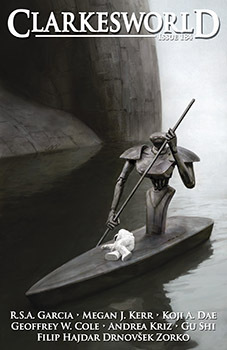 “Talk” by JC Jongwon Park
“Talk” by JC Jongwon Park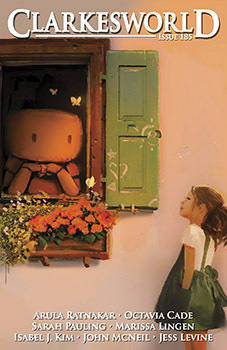 “SurtiBot and Mister Oink” by Alejandro Burdisio
“SurtiBot and Mister Oink” by Alejandro Burdisio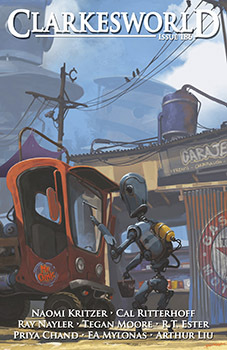 “Ashes” by Yuumei
“Ashes” by Yuumei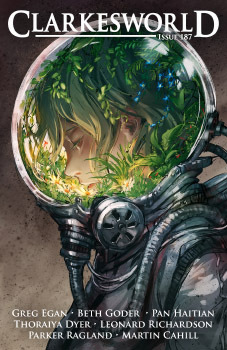 “Shrine of Nameless Stars” by Daniel Ignacio
“Shrine of Nameless Stars” by Daniel Ignacio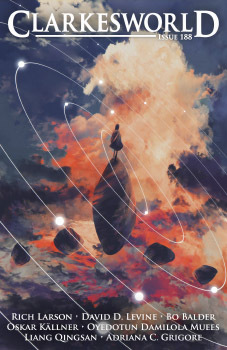 “The Pod” by Eddie Mendoza
“The Pod” by Eddie Mendoza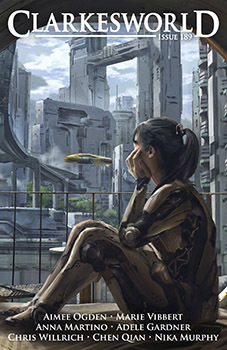 “Red Sand Planet Sightseeing” by Henrik Lundblad
“Red Sand Planet Sightseeing” by Henrik Lundblad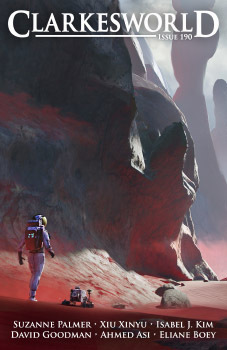 “Transport Walker” by Hamish Frater
“Transport Walker” by Hamish Frater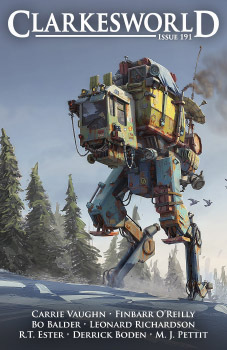 “Canvas of Life – Violet” by Raja Nandepu
“Canvas of Life – Violet” by Raja Nandepu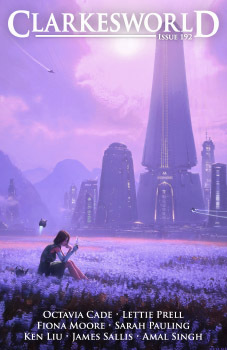 “Art Block” by Daniel Conway
“Art Block” by Daniel Conway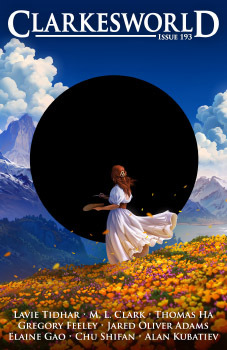 “Canvas of Life – Yellow” by Raja Nandepu
“Canvas of Life – Yellow” by Raja Nandepu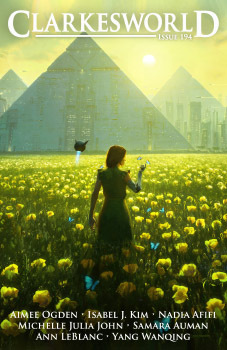 “Rebirth” by Luca Monteleone
“Rebirth” by Luca Monteleone
December 22, 2022
Clarkesworld Gift Subscriptions
One year digital subscriptions to Clarkesworld Magazine can be gifted from the following sites:
ClarkesworldCitizens – Our direct subscription site. (Gift subscriptions are clearly marked. Our system will prompt you for additional information about your recipient before the order is completed.)
Weightless Books – An online independent bookseller. (After you add some ebooks to your cart, you’ll see a checkbox labeled “This is a gift order” just above the Checkout button. Check that box and complete your purchase.)



